Our 2 two-day Great Ocean Road Itinerary takes you on one of the most iconic drives in Australia. The jewel of the journey, the 12 Apostles, is the third most famous natural site in Australia after Uluru and the Great Barrier Reef. It’s not surprising that over 2 million people visit the area each year.
This trip is 48 hours of jaw-dropping beauty, with both coastal and hinterland views to keep your camera busy. The area also boasts some of the state’s best spots for meeting local wildlife. To top that off, some talented local food producers mean any calories burnt walking and climbing stairs are quickly found again.
This page may contain affiliate links. Read our full disclosure policy for more information.
While you can cover this distance in 10 hours return (please use two drivers if you do!), this trip is much better if you allow an overnight stop or two or more!
The Great Ocean Road officially begins at Torquay and ends 243km (151mi) later just outside of Warrnambool
Spending the night at one of the small towns near the 12 Apostles will allow you the joy of both sunset and sunrise, both of which you will remember for a very long time!
If you don’t have time for an overnight stay, I highly recommend letting a specialist handle the driving and book one of these small group tours.
Frequently asked questions about the 12 Apostles
How much do you know about these stunning rock formations? We have tried to cover the most popular questions, but if you have one we have missed, pop over to our FB group and ask us!
How old are the 12 Apostles?
These limestone stacks are believed to be over twenty million years in the making.
Why are they called the 12 Apostles if there are only 7 of them?
Until the 1960s, the rock formation was known as Sow and Pigs. The Sow was Muttonbird Island, and the stacks her piglets. In the 1960s, a marketing campaign saw them renamed from Sow and Piglets to the 12 Apostles even though there were not technically 12 visible. There were nine at one point, but two have collapsed; one in 1995 saw two visitors trapped on the stack away from the shore.
When is the best time to visit the Great Ocean Road?
Advice about driving on the Great Ocean Road
Do not drive at night – Australian country roads attract Kangaroos at dusk and dawn, and accidents are not uncommon. The road is only one lane in each direction, so be careful, particularly when overtaking. It’s a good idea to watch your speed with it changing between 50kph and 100kph quite regularly. Read our guide to driving in Australia if you are an international visitor.
Accidents are sadly not infrequent. When stopping to admire a view, please only use the official areas. If you are flying in from interstate and this is your primary destination, consider a flight to Avalon Airport in Geelong. It will save about an hour of your travelling time, and you can arrive car collection here.
Where are the best places to see on the Great Ocean Road?
In two days, you won’t have time to stop everywhere, so you will need to make a few tough choices. In our itinerary, we made the following cuts:
- We skipped the Torquay – Australian National Surfing Museum, and surf shopping
- Instead, we stopped at the Split Point Lighthouse
- Erskine Falls – near Lorne – a popular stop but we decided to leave it out to make the day a little less rushed.
- Lorne for lunch or Kennett River Reserve for a Koala spotting picnic you don’t have time for both?
Here’s how we spent our two days on the Great Ocean Road.
Day One – Coastal views and Wildlife
We left Melbourne at 6 am, having collected our car the night before. We knew we wanted to be on the road before they opened, so we decided the extra expense of having the vehicle one extra night was worth it.
The total driving time on day one is 4 hours and 30 minutes, not allowing for stops.
The first section of road to Cape Otway is the Surf Coast, from here to Port Fairy is the Shipwreck coast.
Stop 1. Bells Beach
Bells Beach is best known for its annual Easter surf competition, the world’s longest continuously running pro surfing event. The drive here from the centre of Melbourne will take about 75 minutes if you get away early.
A late start will add up to 30 minutes to the trip. Is it a must-see? For me, probably not, but it is nice to stretch the legs.

On a previous visit with our daughter, we had stopped in Torquay, where you will find a bunch of wholesale surf shops – this is a popular stop if you are interested in shopping and you have left late enough in the morning for them to be open.
We spent about 10 minutes here – literally a photo, and away we go.
Stop 2. Aireys Inlet
When we arrived at Aireys Inlet, we were ready to stretch our legs, and there was no way we could miss The Round the Twist Lighthouse, aka Split Point Lighthouse.
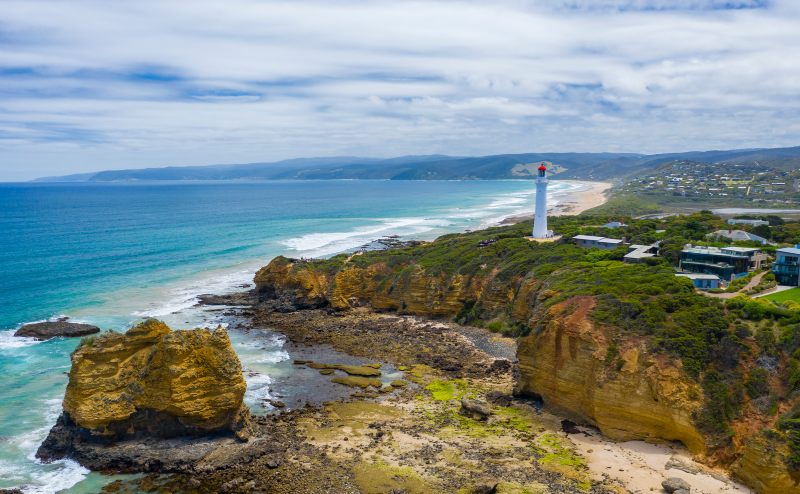
There are two options if you want to go inside the lighthouse. The guided tour takes 45 minutes and costs $15. For $10, you can do the express tour, which is probably enough unless you are really into lighthouse history. You get to climb the four levels to take in the view at the top. Even if you don’t fancy a lighthouse visit, the outlook from this point is lovely.
We spent about 45 minutes here, including a quick run up to the top of the lighthouse and time for photos.
Great Ocean Road QR Trail combines augmented reality, film and art to tell the story of the road
Just before you reach the memorial, keep your eyes peeled for the Pole House
Pitstop – Great Ocean Road Memorial Arch
In August 1918, work began on a road designed to serve as a memorial for the servicemen who lost their lives in World War 1.
The Great Ocean Road is the world’s biggest war memorial. The road took 13 years to build, and over 2300 servicemen made up the 3000-strong workforce. It was completed in 1932.
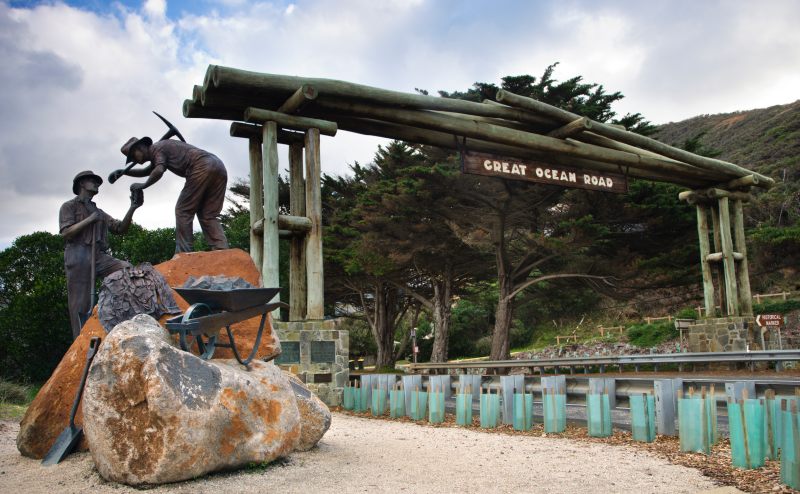
A museum details the history and construction of the road at 15 Mountjoy Parade, Lorne.
Decision time – a sit-down lunch or a walk to a waterfall with a sandwich along the way?
Stop 3. Lorne or Kennett River
Lorne is one of the most significant towns along the GOR, and it’s tempting to stop here for lunch. It’s not a bad decision, there is some excellent food here, but we decided we would prefer to see more and eat less, so we kept driving to Kennett River Coastal Reserve.
We did make one detour to stop at Teddy’s Lookout; it’s a short walk from the car park to the viewing platform to where St George River meets the ocean.
We regret missing is Erskine Falls – a 20km round trip detour – if you have more than two days be sure to add it!
The reserve is best known for the many Koalas found in the gum trees here. It’s called Koala Walk and is one of the best places in Australia to see Koalas in the wild. When you arrive at the Koala Kafe, head along Grey River Road, I suggest going past any tour buses a further km or so till you find some space. Koalas are not fans of noise, so while there may be some near the crowds, you will likely see more further down the road.
We spent about an hour here, including Koala viewing and a takeaway lunch from Koala Kafe.
Stop 4. Apollo Bay
From Kennett River, it’s about 25km to your next stop Apollo Bay the midway point on your drive to the Apostles. It’s now time to take stock. You want to be on the lookout a good 30-45 minutes before sunset, and it’s just under 2 hours drive from here, so depending on how you are going for time, you might need to limit your stop here.
Did you know you can walk the Great Ocean Road? The Great Ocean Walk is a 104 km trail that follows the coast from Apollo Bay to the 12 Apostles.
One view not to miss is Mariners Lookout; you will find it about 3km before you reach the town centre at Apollo Bay. We spent about 30 minutes on this detour and only had a quick drive through town as we wanted to get to our destination in time to stop at the visitor’s centre before sunset.

We spent about 30 minutes at the lookout and 15 minutes in town grabbing coffee.
Once you hit Cape Otway, you are on the “Shipwreck Coast”. Over 50 boats are thought to have been shipwrecked here, and commemorative plaques mark the coastline from here to Port Fairy. Explorer Matthew Flinders said he had never seen a more fearful section of coastline anywhere in his travels, and he circumnavigated the country!
The next part of the drive is through the Cape Otway National Park – If you follow our itinerary, you will be spending tomorrow afternoon here, so resist the urge to stop.
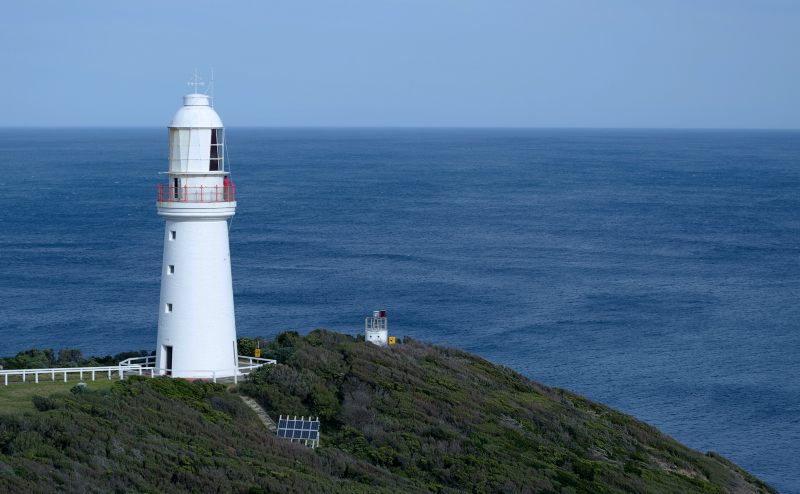
However, if you are making good time and fancy another lighthouse, make the side trip to the Cape Otway Lighthouse. Built in 1848, it is the oldest surviving on the Australian mainland. It keeps watching over the southernmost tip of Australia, where the Bass Strait and the Southern Ocean meet.
Apollo Bay is the starting point for the Great Ocean Walk which is the next multi-day walk we want to tackle
This detour will add about 25km return to your travel time, but I think it’s well worth it. Along the road down to the cape, you will see Mannagum Drive (follow the signs for Otway Ebikes), which is another excellent spot to see Koalas.
Stop 5. 12 Apostles Visitors Centre
Stop in at the official visitors centre and pick up some maps for tomorrow morning’s sightseeing.
If you arrive in time, take a walk down Gibsons Steps to Gibson Beach – from here, you can feel how mighty these limestone “stacks” are. The 86 steps down are not too difficult for anyone with average fitness, and your effort is well rewarded.
Once on the beach, you are at eye level with two small stacks known as Gog and Magog – they are not part of the official Apostle group. Please don’t swim here. The tide can be quite dangerous. Gibson Beach stairs are closed in rough weather.
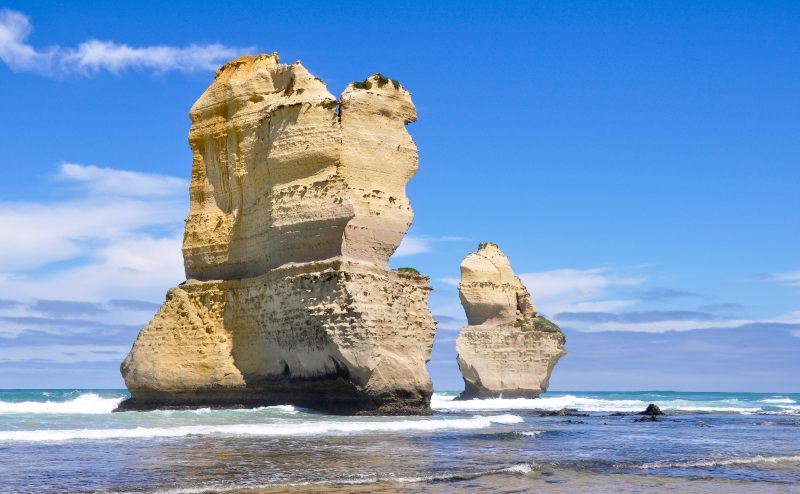
There are two parks on this part of the coast, The Port Campbell National Park and about 30km further along, the Bay of Islands Coastal Park.
Be sure to pick up a map of the various walks in both parks and spend some time this evening choosing a couple for tomorrow. You can download a PDF here if you like to plan.

Sunset at the Twelve Apostles is the main highlight of the day, but shortly after sunset, keep your eye on the beach for the fairy penguins who are returning to sleep. There are two viewing platforms where you are likely to spot them, one here and one at London Bridge. From Loch Ard Gorge, you can also spot mutton birds returning home each evening in season (Sept-April).
Photographers may want to make this a 3-day itinerary to allow time for bad weather and to shoot the other rock formations along the way.
Another popular nighttime activity for those who spend the night on the Great Ocean Road is shooting the Milky Way.
Where to stay at Port Campbell
The prime choices for your overnight stay are:
- Princetown – 6km before the Apostles
- Port Campbell – 12km from the Apostles
- Peterborough – near London Bridge 30km from the 12 Apostles
We chose Port Campbell itself and stayed at a small motel called the Port of Call. When I next go back, I would like to book something self-contained and spend a few more days in the area.
Day 2 Cliffs, Waterfalls, and a Redwood Forest
We suggest you spend the morning exploring Port Campbell National Park and the afternoon taking in some of the waterfalls in Otway National Park. There are 21 stops marked on today’s map, but several are in the same location, so don’t worry; it’s not as bad as it sounds.
If the budget will stretch and you are not scared of heights, a chopper ride is worth every cent.

Stop 1. A 12 Apostles sunrise
The main reason to base yourself here for at least one night is to experience a Great Ocean Rd sunrise. Try to get to the lookout about 30 min or so before the sun comes up for some fantastic light. If you sleep in, don’t fret, the light is excellent for the first few hours of the day, and the crowds are much thinner than at sunset with fewer tour buses around.
Despite their name, according to Parks Vic. there have never been more than 8 “Apostles” the 8th collapsed on July 3, 2005, leaving us with just seven today.
Today there is a fair bit of jumping in and out of the car. You can minimise this by choosing fewer lookouts to cover and perhaps adding a couple more walks. There is a well-reviewed discovery 3.8km walk at Port Campbell that will take you about 90 minutes to complete. We decided against this, as we wanted to be on the road to Otway before midday.
The total driving time between your starting point at the 12 Apostles Lookout and the Bay of Islands National Park is only 35 mins (36km). Still, I would allow 2-3 hours to cover all of these viewpoints depending on how long you spend walking to the various tracks and composing your photos.
Stop 2. Loch Ard Gorge
This spot commemorates the Shipwreck of the Loch Ard in 1878. Only two people, Irish teenagers, survived the wreck, and the nearby Tom and Eva Lookout are named for them. While we were walking on this beach, a wave came from nowhere and almost drenched us. The ocean here can sneak up on you so take care, and please resist the temptation to swim here.
There are several lookouts off this car park, including Tom and Eva, my favourite view at this stop. You will also find Razorback, a very detailed rock, Island Arch, Muttonbird lookout, and Thunder Cave. You can park at Loch Ard car park and walk to all lookouts, each less than a km return except Thunder Cave, which is a little longer. There is a car park closer if you prefer to drive to this one.
Check out some professional shots of these locations to help you decide where to stop
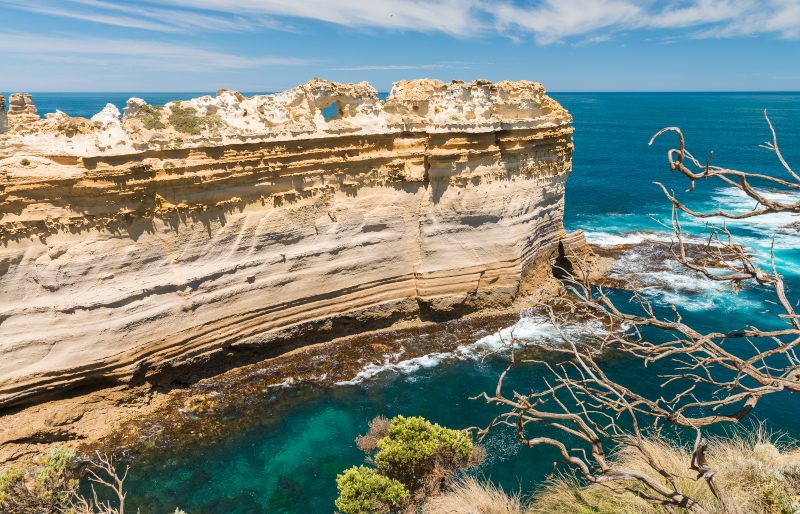
Stop 3. Port Campbell breakfast
Port Campbell is the biggest of the towns along this stretch of the road and an excellent choice for breakfast. We stopped at Forage on the Foreshore and can highly recommend it. Their all-day breakfast features some great local cheese and plenty of healthy options. They open at 9 am, so if you are still too early, you could switch this and the next stop.
Stop 4. The Arch, London Bridge, and The Grotto
This next bit has you in and out of the car every few minutes, and by now, you may be starting to tire of lookouts no matter how pretty. The Arch and The Grotto are similar formations, with The Grotto being superior, so perhaps consider skipping the Arch.

The Arch is impressive though, as it is a chance to see how their erosion forms these stacks over time.
London Bridge was once a double arch but has had a couple of collapses. Until January 1990, you could walk across it, but it collapsed, leaving two visitors needing helicopter rescue. These days it is referred to as London Arch. If you walk to both viewing platforms, allow about 30 minutes.
The Grotto is a cave and sinkhole; the best view is from the lower platform. It is recommended that you stick to the paths and stairways here. The ground can be unstable. Allow about 20 minutes here.
Stop 5. The Bay of Islands Coastal Park
This coastal park covers 32km between Peterborough and Warrnambool. The two bays we stop at today are every bit as pretty as the Port Campbell National Park, and they attract far fewer visitors. If you enjoyed the 12 Apostles but thought it felt like a bit of a circus, then this park will delight you. The stacks are smaller, but there are quite a lot of them, and you may find you have the whole place to yourself.
First up is the Bay of Martyrs, Home to Massacre Bay and Massacre Point; sadly, its history is as dark as its name suggests. Many of the original inhabitants of this land, the Karrae-Wurrong people, were said to be herded off the cliffs into the ocean to their death by the newly arrived Europeans, decimating the local population to almost nil.

The Bay of Islands is just a few km down the road,
Stop 6. Cape Otway Waterfalls
This afternoon it’s all about the waterfalls.
Great Otway National Park has a lot to offer, but its biggest draw cards are its waterfalls and old forest, including a section of Californian redwoods. The area gets decent rainfall year-round, and the waterfalls are almost always flowing.
Unless you have made good time this morning, you will find seeing all the main sites here in one afternoon wildly rushed. I suggest you pick one section, either Triplet Falls and the Otway Fly or Hopetoun/Beauchamp Falls and Redwoods. However, if you want to see it all, put your skates on!
Triplet Falls are only 3km away from the Otway Fly Treetop Adventures and the first spot you see reach when you enter the park from the south.
The walk-to-view Triplet Falls is a 1.8km circuit on a raised boardwalk that is relatively easy and can be completed in one hour. We read that the best route was to do it clockwise, which worked for us.
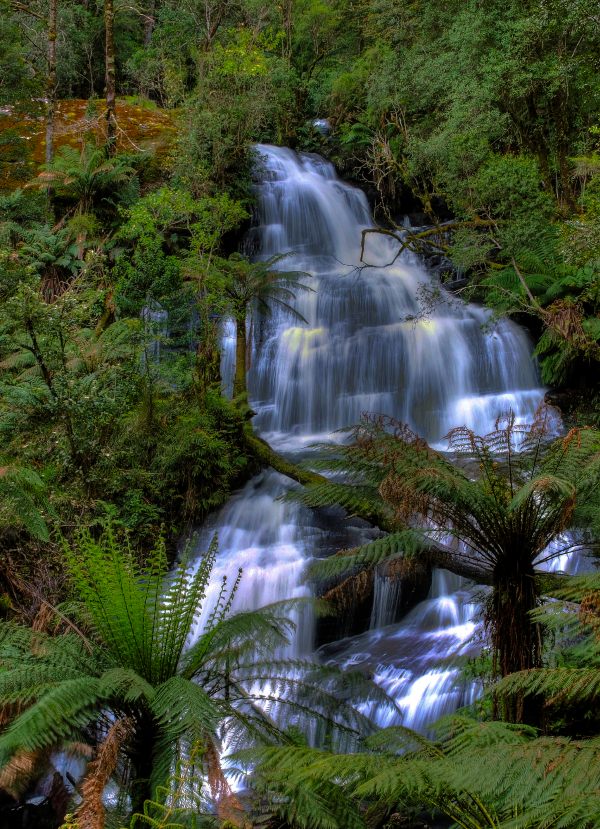
Otway Fly Treetop Walk – The big attraction of this canopy walk is the 600-meter-long, 25-meter-high elevated walkway, the longest and tallest elevated walk in the world. There is also a 47-meter high tower and a 1.9km rainforest walk. Adrenalin junkies can sign up for the zipline adventure.
From here, you are about a twenty-minute drive to Hopetoun Falls

Hopetoun Falls – It’s a 15-minute trip from Beauchamp to Hopetoun Falls. The first lookout is 20 metres from the car park and looks over the falls from the top. You can take a 1km walk to the lookout at the bottom of the falls, but there is no official access to the fall’s base. The trip is 20 minutes to return. From here, it’s a 5-minute drive to the next stop.
Californian Redwoods – I had no idea you could see redwoods in Australia, did you? Only a few minutes drives from Hopetoun Falls, this detour is a must. It’s less than a 500m return to the car, so it won’t add much time to your day. These forests were planted by a local ranger back in 1936.
Beauchamp Falls (pronounced Beechum)- to reach the lookout at the base of this fall requires a bit of effort. The round trip will take you an hour, and you need a decent fitness level. The walk is quite steep and a little challenging. There is no access directly under the falls.
I guarantee the time you spend in the Otways this afternoon will have you planning a return visit before you leave.
So by now, you are probably exhausted – time to head home; we recommend going via Colac. The drive should take you about two and a half hours. If you are spending more time in Melbourne, you might like some of these walks.
If all this has you exhausted and you would prefer someone else to worry about the timing, these tours are worth considering.
Want more road trip inspiration? Check out these ideas:
- Adventures in Lightning Ridge
- The Must-See Stops on the Waterfall Way
- Visit Port Macquarie on the NSW Mid-North Coast
2 Day Great Ocean Road itinerary map
Save your Great Ocean Road Itinerary and map for your trip.
Got a question? Head over to our Australia Travel Tips Facebook Group and ask a local.

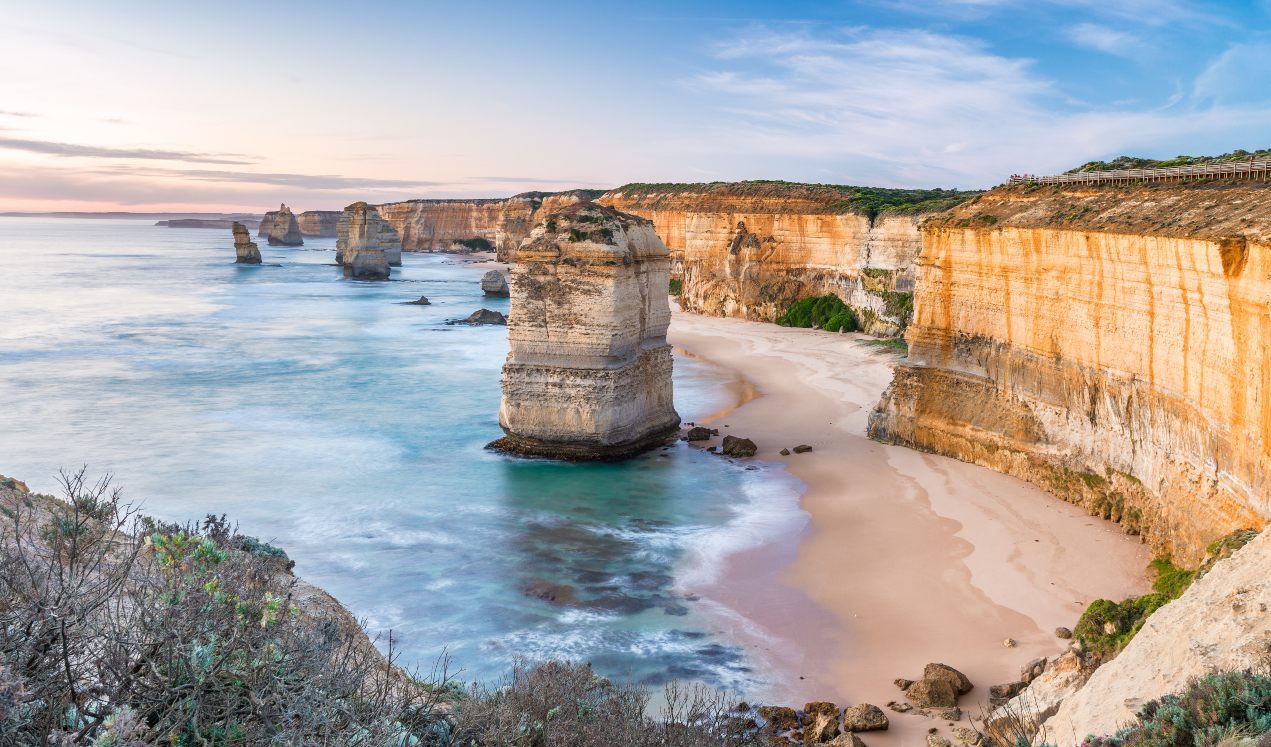
Gosh, you had me from that very first picture of the 12 Apostles! This looks like the most incredibly beautiful journey. When we can travel again, I might have to consider a “boy’s gone to uni, so I can travel more freely” trip to Australia 🙂